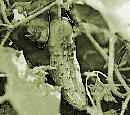
|
The Cucumber: Past and Present
|

|
A creeping plant of the Cucurbitaceae family, which includes the genera Citrullis (watermelon), and Cucurbita (pumpkin and squash). The genus Cucumis sativus comprises about forty species, including muskmelons, honeydews, and cantaloupes.
The cucumber probably originated in northern India and is widely cultivated throughout the world for its fruit. It is a tender annual with a rough, succulent, trailing stem and hairy leaves; the stem bears branched tendrils by which the plant can be lashed to supports.
The oblong vegetable grows easily in a variety of climates; Russian cosmonauts once grew cucumbers on Mir during a 211-day mission. It is, however, extremely sensitive to the cold. When planting, an excess of seed is sown and the small plants are thinned to the number desired. There are three groups of varieties: the very large-fruited, strong-growing varieties adapted only to greenhouse or frame culture; the large-fruited, outdoor-grown plants generally having white spines, which are used primarily for slicing and pickling; and the small-fruited, prolific kinds with spines which are grown outdoors principally for pickling.
Cucumber length ranges from the gherkin (between one and two inches) to the English cucumber (up to 15 inches long). The largest ever cucumber was grown in Australia in 1988. It weighed 59 pounds.
The food value of the cucumber is low; it contains 96 percent water. However, its delicate flavor and crispness makes it popular. Fresh cucumbers should be firm, well-shaped, and bright green in color. The rough skin is edible, although many farms wax it to prolong self-life. Cucumbers may be kept in refrigerated storage for up to two weeks. The internal temperature of a cucumber can be as much as 20 degrees cooler than the outside air.
The English word "cucumber" derives from the name cowcumber, which relates to an early 17th century English belief that the vegetable was fit only for consumption by cows. At the time, it was widely reported that the cucumber was especially harmful to children and could even be fatal.
Excavation at the Spirit Cave site on the Burma-Thailand frontier uncovered seeds of cucumbers that, according to radiocarbon dating, had been consumed in 9750 B.C. The first records of cucumber cultivation date back 3000 years in parts of India. Greeks brought it into Europe and the Romans-who were particularly fond of the vegetable-introduced it to the rest of the continent. Spaniards brought cucumbers to Haiti in 1494.
Many cultures have adapted cucumbers into their mythology. In Chinese mythology, Li Tieh-kuai, one of the eight Immortals, tied a cucumber charm to his magic staff and from it clouds of vapor rose to free his spirit. Burmese legends tell of Yatawn and Yatai beginning a passionate romance after nibbling on a cucumber, from whence sprang the entire Indo-Chinese race. In the Bible, the Israelites in the wilderness complained to Moses that they missed the luxuries they had in Egypt, including the cucumber. Some authorities believe the Biblical cucumber to be in fact a melon.
The modern cucumber gradually evolved without planned hybridization or selection until 1872, when Tailby's hybrid was exhibited. Thereafter much attention was devoted to the breeding and development of the cucumber. Most varieties familiar to contemporary readers emerged after the beginning of the 20th century. These vegetables bear little resemblance to cucumbers of centuries past.